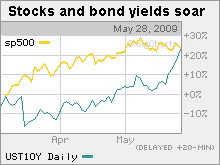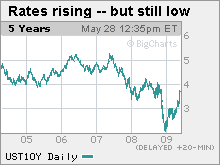What's driving the great bond freak out
Yields on long-term Treasurys have surged as investors worry about a supply glut and inflation. But rates aren't too high to be a cause for concern - yet.

 |
| Investors have sold low-risk bonds to move into stocks as economic recovery hopes have grown. And falling bond prices push up bond yields. |
 |
| Even though the yield on the benchmark 10-year Treasury has risen sharply in the past few months, rates are still considerably lower than where they were just a few years ago. |
NEW YORK (CNNMoney.com) -- The government is going deeper into hock and that's starting to make people nervous.
Investors have been dumping long-term Treasurys as of late on concerns about a glut of bonds flooding the market this week. And that's pushed rates, which move in the opposite direction of bond prices, to their highest level since November.
The yield on the U.S. 10-year Treasury note has shot up to about 3.7% this week following auctions of $40 billion auction in 2-year notes Tuesday, $35 billion in 5-year notes Wednesday and $26 billion in 7-year notes Thursday.
Simply put, it's growing increasingly difficult to imagine that there will be enough demand for all these Treasurys.
"The market is having a tough time absorbing all this debt. There's so much supply," said Stephen Mahoney, a portfolio manager with Glenmede Investment Management, an investment firm in Philadelphia with about $4 billion in fixed income assets.
The bond auctions are setting off alarm bells for people who believe the government is spending too much money to finance the myriad programs aimed at getting the economy back on solid footing.
The stimulus package passed by Congress and the alphabet soup list of rescue plans launched by the Treasury and Federal Reserve for the nation's financial system could cost more than $10 trillion.
The fear is that all this liquidity will lead to inflation down the road. To that end, some point to the recent deterioration in the dollar versus other currencies and the rise in oil prices as evidence that inflation is already starting to creep back into the economic picture.
Talkback: Are you worried about how much the government is spending in order to get the economy back on track? Leave your comments at the bottom of this story.
But let's take a step back and a deep breath for a moment. While the spike in bond yields is alarming because of how quickly it has taken place - the yield on the 10-year was as low as 2.2% in early January - rates are still, by all normal measures, relatively low.
Long-term Treasury yields are now around the level they were at in early September before Lehman Brothers filed for bankruptcy. And much of the slide in yields between that point and earlier this year was due to investors panicking. They were unloading stocks, commodities and other assets and flocking to what they thought to be the only safe bet left on the planet - U.S. Treasurys.
The world has changed a lot since then - or at the very least, the perception of it has. Most investors are no longer fearing massive bank failures and another Great Depression. Instead, many are betting on a recovery. So it's no coincidence that stocks have soared at the same time bonds have fallen.
"Investors are increasingly willing to take on more risk," said Bruce McCain, chief investment strategist with Key Private Bank in Cleveland. "There has been a change in market psychology and the perspective on the economy. And when the flight to quality ends, people often look to sell Treasurys to buy other assets."
With that in mind, it's important to try and figure out where bonds will go next. Are yields going to keep heading north or stabilize around this level? If it's the latter, that's not necessarily a terrible thing. Remember, the 10-year yield is now at a 6-month high, not a 6-year high.
"The rise in rates has not been severe enough to put recovery at risk just yet. Plus, rates usually rise heading out of recessions," McCain said.
But if rates head substantially higher, that could put upward pressure on the rates for many consumer and business loans. In fact, it's already happening.
According to the most recent weekly survey about mortgage rates from Bankrate.com, the average 30-year fixed-rate mortgage rose from 5.24% a week ago to 5.45% this week.
Mahoney said the yield on the 10-year could go as high as 3.75% in the short-term. (Yields briefly touched that level Thursday afternoon.) And he thinks that could cause the Fed to step up its purchase of long-term Treasurys in order to try and drive rates lower again.
The Fed announced in March it planned to buy $300 billion in long-term Treasurys, but Mahoney believes the Fed needs to be more aggressive to prove that it's committed to keeping rates low - particularly to investors like China and Japan that own a lot of Treasurys.
"If rates continue to go up because of more supply, that's not going to bode well overseas," he said. And that could just make things worse because sales by big foreign investors could fuel further spikes in bond rates.
"If rates continue to rise, it could slow down the economy," Mahoney said. "Mortgage rates would go higher which could hurt the housing market -- and the housing market is what brought us into this mess."
Talkback: Are you worried about how much the government is spending in order to get the economy back on track? ![]()

